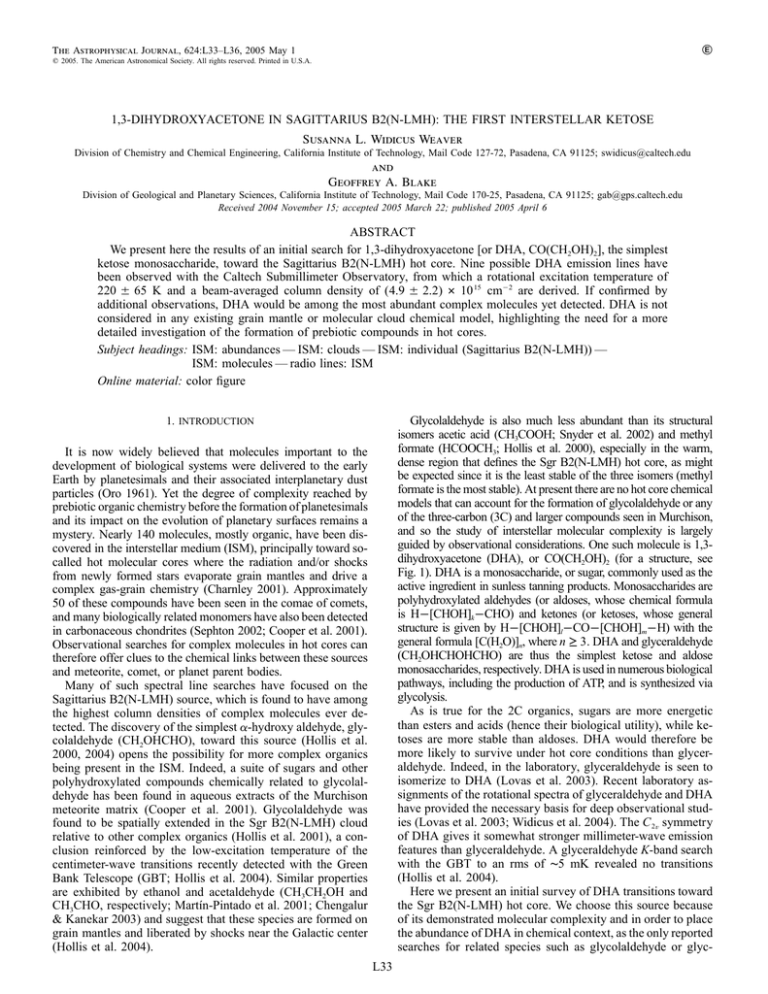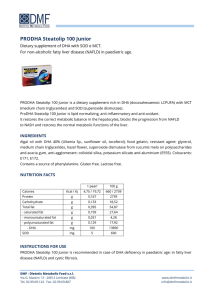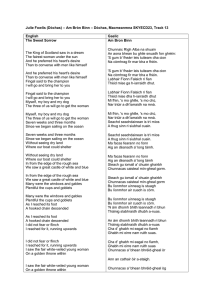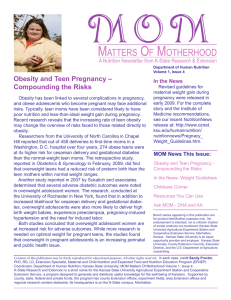
The Astrophysical Journal, 624:L33–L36, 2005 May 1
䉷 2005. The American Astronomical Society. All rights reserved. Printed in U.S.A.
1,3-DIHYDROXYACETONE IN SAGITTARIUS B2(N-LMH): THE FIRST INTERSTELLAR KETOSE
Susanna L. Widicus Weaver
Division of Chemistry and Chemical Engineering, California Institute of Technology, Mail Code 127-72, Pasadena, CA 91125; swidicus@caltech.edu
and
Geoffrey A. Blake
Division of Geological and Planetary Sciences, California Institute of Technology, Mail Code 170-25, Pasadena, CA 91125; gab@gps.caltech.edu
Received 2004 November 15; accepted 2005 March 22; published 2005 April 6
ABSTRACT
We present here the results of an initial search for 1,3-dihydroxyacetone [or DHA, CO(CH2OH)2], the simplest
ketose monosaccharide, toward the Sagittarius B2(N-LMH) hot core. Nine possible DHA emission lines have
been observed with the Caltech Submillimeter Observatory, from which a rotational excitation temperature of
220 Ⳳ 65 K and a beam-averaged column density of (4.9 Ⳳ 2.2) # 10 15 cm⫺2 are derived. If confirmed by
additional observations, DHA would be among the most abundant complex molecules yet detected. DHA is not
considered in any existing grain mantle or molecular cloud chemical model, highlighting the need for a more
detailed investigation of the formation of prebiotic compounds in hot cores.
Subject headings: ISM: abundances — ISM: clouds — ISM: individual (Sagittarius B2(N-LMH)) —
ISM: molecules — radio lines: ISM
Online material: color figure
Glycolaldehyde is also much less abundant than its structural
isomers acetic acid (CH3COOH; Snyder et al. 2002) and methyl
formate (HCOOCH3; Hollis et al. 2000), especially in the warm,
dense region that defines the Sgr B2(N-LMH) hot core, as might
be expected since it is the least stable of the three isomers (methyl
formate is the most stable). At present there are no hot core chemical
models that can account for the formation of glycolaldehyde or any
of the three-carbon (3C) and larger compounds seen in Murchison,
and so the study of interstellar molecular complexity is largely
guided by observational considerations. One such molecule is 1,3dihydroxyacetone (DHA), or CO(CH2OH)2 (for a structure, see
Fig. 1). DHA is a monosaccharide, or sugar, commonly used as the
active ingredient in sunless tanning products. Monosaccharides are
polyhydroxylated aldehydes (or aldoses, whose chemical formula
is Hi[CHOH]k iCHO) and ketones (or ketoses, whose general
structure is given by Hi[CHOH]l iCOi[CHOH]m iH) with the
general formula [C(H2O)]n, where n ≥ 3. DHA and glyceraldehyde
(CH2OHCHOHCHO) are thus the simplest ketose and aldose
monosaccharides, respectively. DHA is used in numerous biological
pathways, including the production of ATP, and is synthesized via
glycolysis.
As is true for the 2C organics, sugars are more energetic
than esters and acids (hence their biological utility), while ketoses are more stable than aldoses. DHA would therefore be
more likely to survive under hot core conditions than glyceraldehyde. Indeed, in the laboratory, glyceraldehyde is seen to
isomerize to DHA (Lovas et al. 2003). Recent laboratory assignments of the rotational spectra of glyceraldehyde and DHA
have provided the necessary basis for deep observational studies (Lovas et al. 2003; Widicus et al. 2004). The C 2 v symmetry
of DHA gives it somewhat stronger millimeter-wave emission
features than glyceraldehyde. A glyceraldehyde K-band search
with the GBT to an rms of ∼5 mK revealed no transitions
(Hollis et al. 2004).
Here we present an initial survey of DHA transitions toward
the Sgr B2(N-LMH) hot core. We choose this source because
of its demonstrated molecular complexity and in order to place
the abundance of DHA in chemical context, as the only reported
searches for related species such as glycolaldehyde or glyc-
1. INTRODUCTION
It is now widely believed that molecules important to the
development of biological systems were delivered to the early
Earth by planetesimals and their associated interplanetary dust
particles (Oro 1961). Yet the degree of complexity reached by
prebiotic organic chemistry before the formation of planetesimals
and its impact on the evolution of planetary surfaces remains a
mystery. Nearly 140 molecules, mostly organic, have been discovered in the interstellar medium (ISM), principally toward socalled hot molecular cores where the radiation and/or shocks
from newly formed stars evaporate grain mantles and drive a
complex gas-grain chemistry (Charnley 2001). Approximately
50 of these compounds have been seen in the comae of comets,
and many biologically related monomers have also been detected
in carbonaceous chondrites (Sephton 2002; Cooper et al. 2001).
Observational searches for complex molecules in hot cores can
therefore offer clues to the chemical links between these sources
and meteorite, comet, or planet parent bodies.
Many of such spectral line searches have focused on the
Sagittarius B2(N-LMH) source, which is found to have among
the highest column densities of complex molecules ever detected. The discovery of the simplest a-hydroxy aldehyde, glycolaldehyde (CH2OHCHO), toward this source (Hollis et al.
2000, 2004) opens the possibility for more complex organics
being present in the ISM. Indeed, a suite of sugars and other
polyhydroxylated compounds chemically related to glycolaldehyde has been found in aqueous extracts of the Murchison
meteorite matrix (Cooper et al. 2001). Glycolaldehyde was
found to be spatially extended in the Sgr B2(N-LMH) cloud
relative to other complex organics (Hollis et al. 2001), a conclusion reinforced by the low-excitation temperature of the
centimeter-wave transitions recently detected with the Green
Bank Telescope (GBT; Hollis et al. 2004). Similar properties
are exhibited by ethanol and acetaldehyde (CH3CH2OH and
CH3CHO, respectively; Martı́n-Pintado et al. 2001; Chengalur
& Kanekar 2003) and suggest that these species are formed on
grain mantles and liberated by shocks near the Galactic center
(Hollis et al. 2004).
L33
L34
WIDICUS WEAVER & BLAKE
Fig. 1.—Simulated spectrum of 1,3-dihydroxyacetone (DHA) lines at 220 K
compared to an observed Sgr B2(N-LMH) spectrum. The structure of DHA is
shown in the inset. [See the electronic edition of the Journal for a color version
of this figure.]
eraldehyde and other structurally similar complex organics such
as ethylene glycol (HOCH2CH2OH) and acetone [(CH3)2CO]
are toward Sgr B2(N-LMH). The observations are presented
in § 2, while an analysis of the observed spectral lines is reported in § 3. The Letter concludes with a short discussion of
the possible chemical implications of this work in § 4.
2. OBSERVATIONS
A search for DHA emission in the 1.3 mm atmospheric window was conducted with the Caltech Submillimeter Observatory
(CSO). The parameters for the DHA lines used in this search,
specifically the transition quantum numbers, rest frequencies,
Einstein A-coefficients times the upper state degeneracy, and
upper state energies, are listed in Table 1. All observed lines are
transitions within the ground vibrational state. Many of these
lines are actually asymmetry doublets or blends of multiple transitions between similar yet distinct quantum states that lie at
nearly the same energy. These will appear in observational spec-
Vol. 624
tra as a single blended line because of the ⲏ10 km s⫺1 line
widths characteristic of Sgr B2. Only one frequency has been
listed for asymmetry doublets occurring at the same frequency;
for all others, the frequency of each individual component has
been listed.
The survey was conducted using the CSO 230 GHz doublesideband (DSB) heterodyne receiver on the nights of 2003 July
13–23/September 14–21 and of 2004 June 30–July 7. Typical
system temperatures ranged from 200 to 600 K, and the source
s
d(1950) p
position selected was a(1950) p 17h44m10.1,
⫺28⬚21⬘17⬙, which is coincident with the Sgr B2(N-LMH) hot
core. The chopping secondary with a 70⬙ throw was used along
with chopper-wheel calibration and the facility 1.5 GHz,
500 MHz, and 50 MHz acousto-optic spectrometer (AOS) back
ends to minimize the spectral baseline fluctuations. The FWHM
of the CSO at these frequencies is ∼30⬙, and all data are placed
on the TMB temperature scale using a main-beam efficiency of
70% determined using observations of the planets. Line confusion was a perpetual difficulty that we faced during the observations due to the DSB setup of the CSO and the dense
spectral nature of the Sgr B2(N-LMH) source. Line positions
were therefore verified by observing at each local oscillator
(LO) setting with several small frequency offsets. A v LSR of 62
km s⫺1 was used for the 2003 July observations. Potential
dihydroxyacetone lines were observed at 64 km s⫺1, and so
this v LSR was then used for the remaining observations.
3. RESULTS
A total of nine possible DHA emission lines were detected
with the CSO with a mean v LSR of 63.4 Ⳳ 3.2 km s⫺1. The
observational spectra from the 500 MHz AOS in the v LSR p
0–100 km s⫺1 window are shown in Figure 2. The v LSR scales
have been adjusted such that the LO frequency is centered at
64 km s⫺1. Nine additional lines were either severely blended
with other lines or completely obscured by stronger features
in the signal or image sideband. No DHA lines were found to
be absent from any clean 1.3 mm spectral windows observable
at the CSO.
Least-squares Gaussian fits to each observed line are summarized in Table 1 and shown in Figure 2. The integrated in-
TABLE 1
A Summary of DHA Emission Lines from Sgr B2(N-LMH)
n0a
(MHz)
219059.1 . . . . . .
222826.4 . . . . . .
222839.4 . . . . . .
222847.0 . . . . . .
222861.1 . . . . . .
223293.9 . . . . . .
243591.0 . . . . . .
243593.0 . . . . . .
254459.9 . . . . . .
261654.3 . . . . . .
a
b
c
JK a , Kc –JKa, Kc
Agu
(102 s⫺1)
Eu
(K)
TMBb
(K)
Dvc
(km s⫺1)
(km s⫺1)
vLSRc
1411, 3–1310, 4
1411, 4–1310, 3
613, 58–604, 57
614, 58–603, 57
1511, 4–1410, 5
1511, 5–1410, 4
605, 56–594, 55
631, 62–622, 61
632, 62–621, 61
673, 64–664, 63
674, 64–663, 63
721, 71–712, 70
722, 71–711, 70
750, 75–741, 74
751, 75–740, 74
1.23
1.23
5.17
5.71
1.44
1.44
4.78
6.78
6.78
8.53
8.53
11.67
11.67
14.30
14.30
64.98
64.98
344.98
344.98
67.71
67.71
341.68
349.60
349.60
412.61
412.61
453.49
453.49
479.97
479.97
0.14
10.60(16)
62.91(17)
0.48
0.39
0.35
11.50(250)
7.74(224)
8.29(252)
64.50(21)
65.23(26)
60.74(40)
0.19
0.40
10.77(132)
17.36(64)
63.24(42)
62.38(9)
0.24
13.12(51)
63.78(10)
0.20
8.95(140)
65.86(19)
0.18
9.22(46)
62.31(12)
1 j uncertainties are 0.1 MHz.
1 j uncertainties are !10 mK.
1 j uncertainties are listed in parentheses in units of last significant figure.
No. 1, 2005
1,3-DIHYDROXYACETONE IN SGR B2
L35
the partition function, Trot is the molecular rotational temperature, and Eu is the transition upper state energy (Nummelin
et al. 1998b). Only the ground and first four DHA vibrational
states are populated at T ⱗ 250 K, and a full rotational analysis
has been performed for these states (Widicus et al. 2004). The
rotational constants determined for each vibrational state have
therefore been used such that the partition function is approximated as
冘
4
Q(Trot ) ≈
ip0
冑A Bp C (kTh ) .
3
e⫺Ei /kTrot
rot
i
i
(2)
i
A plot of ln [(8pkn 2 )/(hc 3Agu ) ∫⫺⬁ Tb dv] versus Eu therefore
gives a line with a slope inversely proportional to Trot and with
an intercept equal to ln [NT /Q(Trot )]. The rotation diagram for
DHA is shown in Figure 3. A molecular rotational temperature
of 222 Ⳳ 65 K and a column density of (4.9 Ⳳ 2.2) # 10 15 cm⫺2
were derived, where the errors represent 95% confidence intervals.
Four lines corresponding to DHA transitions were observed
in one window at the 222839.40 MHz LO setting (Fig. 2b);
these data are shown in Figure 1 along with a Trot p 220 K
simulated spectrum. The relative intensities, line-center frequencies, and line widths of the DHA lines were fixed, and
the intensities scaled, to best match the observed spectrum. The
additional strong line is due to H 13
2 CO in the image sideband,
and all parameters for this line were fixed to those determined
by Nummelin et al. (1998a). The simulation shows that other
unidentified spectral features may be present in the DSB spectrum and that the integrated intensity of the 222826.4 MHz
DHA line is most affected by these features. It is therefore not
included in the rotation-diagram analysis.
A spectral window overlapping in frequency with two strong
dihydroxyacetone lines has also been observed in deep integrations with the Kitt Peak 12 m telescope (J. M. Hollis 2004,
private communication). There are emission features at the appropriate frequencies for these DHA transitions, but one of the
lines appears to be blended with an unidentified line. Their
inclusion in the rotation-diagram analysis is quite difficult because of the lack of information regarding line widths for DHA
emission features in this frequency range, and therefore these
data have not been included in this study.
⬁
Fig. 2.—Possible DHA transitions observed toward Sgr B2(N-LMH) with the
least-squares Gaussian fits to each line. Spectra are from the CSO 500 MHz
AOS, and a linear baseline subtraction of the continuum has been performed.
The vertical dotted line indicates vLSR p 64 km s⫺1. (b) The positions of additional
DHA lines relative to 64 km s⫺1 are indicated in the spectrum.
tensity was calculated using ∫⫺⬁ Tb dv p 1.064TMB Dv, where
TMB is the peak line intensity corrected to the main-beam temperature scale (TA∗/0.7 for the CSO at 230 GHz) and Dv is the
line width FWHM. No beam dilution corrections were applied
because the spatial scale of the emission is unknown. Only single
Gaussian fits are reported here since many of the potentially
blended lines in Figure 2 are unassigned, and hence the relative
contributions from individual features are poorly constrained.
A rotation-diagram approach was used to determine the rotational temperature and column density of DHA toward Sgr
B2(N-LMH) in the limit of local thermal equilibrium and optically thin emission. The background radiation brightness has
also been assumed to be negligible. Under these conditions the
⬁
integrated intensity of a transition, ∫⫺⬁ TMB dv, is
⬁
冕
⬁
⫺⬁
TMB dv p
hc 3
NT
Ag
e⫺Eu /kTrot,
8pkn 2 u Q(Trot )
(1)
where n is the transition frequency, NT is the beam-averaged
total column density (over ∼30⬙ here), A is the transition Einstein A-coefficient, gu is the upper state degeneracy, Q(Trot ) is
Fig. 3.—Rotation diagram for DHA toward SgrB2(N-LMH). The labels
correspond to the panels of Fig. 2.
4. DISCUSSION
These results are the first observational evidence for the presence of the 3C ketose 1,3-dihydroxyacetone in the ISM. The
derived DHA excitation and velocity are in excellent agreement
with other species detected in the Sgr B2(N-LMH) hot core, for
which the most commonly quoted rotational temperature and
v LSR are 200 K and 64 km s⫺1, respectively (see Liu et al. 2001
and references therein). The derived DHA column density of
(4.9 Ⳳ 2.2) # 10 15 cm⫺2 does lead to interesting questions about
the formation of and subsequent behavior of this molecule in
the hot core, however. Emission from the high-excitation lines
of methyl formate, acetic acid, ethyl cyanide (CH3CH2CN), dimethyl ether (CH3OCH3), and acetone [(CH3)2CO] is known to
be compact with respect to the CSO beam (see Snyder et al.
2002 and references therein). If similar filling factors are used
for DHA, then it would be more abundant than any of these
compounds except dimethyl ether. Both the chopping scheme
and the higher frequencies of CSO observations render them
insensitive to spatial distribution for extended, low-excitation
emission as is seen from molecules such as acetaldehyde, ethanol,
L36
WIDICUS WEAVER & BLAKE
and glycolaldehyde. Direct comparisons show that these molecules are also less abundant than DHA.
A further complication is the inconsistent treatment of the
partition functions of complex molecules. Typically only the
ground vibrational state is included in partition function calculations as laboratory characterizations of excited states are
often incomplete. The inclusion of vibrational state terms can
greatly affect the derived total column densities of complex
species under hot core conditions. For a molecule like glycolaldehyde, the inclusion of torsional states increases the partition function by ∼50% at 200 K, but they can be safely ignored
below 50 K (Widicus Weaver et al. 2005). The exclusion of
excited vibrational state terms in the DHA analysis would lower
the column density by ∼60%.
Nevertheless, DHA would be among the most abundant complex molecules in the Sgr B2(N-LMH) hot core should the
present analysis be confirmed by further observations, and so an
efficient formation route must exist. No quantitative chemical
scheme for the production of species such as glycolaldehyde and
DHA has been presented. Observations of complex molecules
toward low-mass protostars where the dynamical timescales are
short (Schöier et al. 2002; Cazaux et al. 2003) and careful studies
of the potential reactions leading to HCOOCH3 all seem to point
toward a grain mantle synthesis (Horn et al. 2004). In this regard
it is intriguing to note that, with appropriate rearrangements, all
of these species can be formed from reactions involving the
abundant grain mantle constituents CO, HCOOH, and CH3OH
or their radical precursors.
Survivability in hot cores may be another important aspect
of DHA chemistry. As a ketose, it is both thermodynamically
more stable and less reactive than both glycolaldehyde and
glyceraldehyde in hot gas. Isomerism in 3C and larger compounds is also quite extensive, and both dimethyl carbonate
[(CH3O)2CO] and methyl glycolate (CH3OCOCH2OH) are even
more stable than DHA. These isomers would likely be created
by any surface chemistry leading to sugars. The microwave
spectrum of methyl glycolate is known (Brochu & Buckley
1973), and the microwave spectrum of dimethyl carbonate as
well as the (sub)millimeter spectra of both species have recently
been obtained in our laboratory. Observational searches for
these molecules are planned for the upcoming observing season, and the relative abundances of the 3C compounds should
place stringent constraints on their possible formation routes.
Vol. 624
The spectral characteristics of asymmetric rotors such as
DHA make a definitive interstellar detection quite difficult.
While some spectral windows contain multiple emission lines,
most contain only one strong line due to the relatively large
spacing between adjacent K levels within a given J state. It
can be argued that many of the isolated features presented here
could arise from other unidentified species or from the excited
vibrational state lines of previously detected molecules. This
argument is countered by the striking similarity between the
observed and simulated spectra shown in Figure 1. This degree
of coincidental overlap with other hot core species in both rest
frequency and intensity is unlikely, but additional observations
are clearly warranted.
Combined centimeter⫹millimeter observations are particularly powerful, and additional DHA observations with the GBT
are planned for winter 2005. Other molecules observed in Sgr
B2(N-LMH) show two-component behavior in which higher energy transitions give characteristic hot core temperatures but in
which lower energy transitions yield much colder excitation temperatures. It is thought that these lower energy states are populated in an extended, potentially subthermal, source, possibly
formed by shock-liberated grain mantle ices (Martı́n-Pintado et
al. 2001; Hollis et al. 2004). DHA should demonstrate such
behavior if it is produced by a grain surface mechanism, and so
the GBT observations should offer considerable insight into the
formation of this molecule. The determination of the spatial scale
of DHA emission toward Sgr B2(N-LMH) is another important
step in the characterization of this molecule, and further aperture
synthesis observations to this end are underway.
We are grateful to J. M. Hollis, L. E. Snyder, S. Y. Liu, and
A. R. Remijan for their advice and guidance during the completion of this project, especially in regards to the complex
velocity fields of Sgr B2(N-LMH). We would also like to thank
S. Bisschop, R. Braakman, A. Boogert, and A. Walsh for their
assistance as backup observers at the CSO, and B. Drouin for
his insight into molecular partition functions. We gratefully
acknowledge the patience and generosity of the CSO TAC and
would like to thank the CSO staff for their support during
observations. Observations with the CSO are supported by NSF
grant AST-0229008; additional support was provided by the
NASA Exobiology and SARA programs, grants NAG5-8822
and NAG5-11423.
REFERENCES
Brochu, M., & Buckley, P. 1973, Canadian J. Spectrosc., 18, 165
Cazaux, S., Tielens, A. G. G. M., Ceccarelli, C., Castets, A., Wakelam, V.,
Caux, E., Parise, B., & Teyssier, D. 2003, ApJ, 593, L51
Charnley, S. 2001, in The Bridge between the Big Bang and Biology, ed. F.
Giovanelli (Rome: Consiglio Naz. Ric.), 139
Chengalur, J. N., & Kanekar, N. 2003, A&A, 403, L43
Cooper, G., Kimmich, N., Belisle, W., Sarinana, J., Brabham, K., & Garrel,
L. 2001, Nature, 414, 879
Hollis, J. M., Jewell, P. R., Lovas, F. J., & Remijan, A. 2004, ApJ, 613, L45
Hollis, J. M., Lovas, F. J., & Jewell, P. R. 2000, ApJ, 540, L107
Hollis, J. M., Vogel, S. N., Snyder, L. E., Jewell, P. R., & Lovas, F. J. 2001,
ApJ, 554, L81
Horn, A., Møllendal, H., Sekiguchi, O., Uggerud, E., Roberts, H., Herbst, E.,
Viggiano, A. A., & Fridgen, T. D. 2004, ApJ, 611, 605
Liu, S. Y., Mehringer, D. M., & Snyder, L. E. 2001, ApJ, 552, 654
Lovas, F. J., Suenram, R. D., Plusquellic, D., & Møllendal, H. 2003, J. Mol.
Spectrosc., 222, 263
Martı́n-Pintado, J., Rizzo, J. R., de Vicente, P., Rodrı́guez-Fernández, N. J.,
& Fuente, A. 2001, ApJ, 548, L65
Nummelin, Å., Bergman, P., Hjalmarson, A., Friberg, P., Irvine, W. M., Millar,
T. J., Ohishi, M., & Saito, S. 1998a, ApJS, 117, 427
Nummelin, A., Dickens, J. E., Bergman, P., Hjalmarson, Å., Irvine, W. M.,
Ikeda, M., & Ohishi, M. 1998b, A&A, 337, 275
Oro J. 1961, Nature, 190, 389
Schöier, F. L., Jørgensen, J. K., van Dishoeck, E. F., & Blake, G. A. 2002,
A&A, 390, 1001
Sephton, M. A. 2002, Nat. Prod. Rep., 19, 292
Snyder, L. E., Lovas, F. J., Mehringer, D. M., Miao, N. Y., Kuan, Y.-J., Hollis,
J. M., & Jewell, P. R. 2002, ApJ, 578, 245
Widicus, S. L., Braakman, R., Kent, D. R., & Blake, G. A. 2004, J. Mol.
Spectrosc., 224, 101
Widicus Weaver, S. L., et al. 2005, ApJS, in press
The Astrophysical Journal, 632:L163–L163, 2005 October 20
䉷 2005. The American Astronomical Society. All rights reserved. Printed in U.S.A.
ERRATUM: “1,3-DIHYDROXYACETONE IN SAGITTARIUS B2(N-LMH): THE FIRST INTERSTELLAR KETOSE”
(ApJ, 624, L33 [2005])
Susanna L. Widicus Weaver
Division of Chemistry and Chemical Engineering, California Institute of Technology1
and
Geoffrey A. Blake
Division of Geological and Planetary Science, California Institute of Technology
The Einstein A-coefficients times the upper state degeneracy values (Agu ) in Table 1 were calculated incorrectly because of an
inconsistency in the partition functions used to generate the spectral predictions presented in the laboratory work (S. L. Widicus,
R. Braakman, D. R. Kent IV, & G. A. Blake, J. Mol. Spectrosc., 224, 101 [2004]) and in the submillimeter and microwave spectral
line catalog available at http://spec.jpl.nasa.gov (H. M. Pickett, R. L. Poynter, E. A. Cohen, M. L. Delitsky, J. C. Pearson, &
H. S. P. Muller, J. Quant. Spectrosc. Radiat. Transfer, 60, 883 [1998]). We thank J. M. Hollis for bringing this discrepancy to our
attention. The correct Agu values are reported in Table 1 below.
⬁
This correction increases the quantity ln [(8pkn 2 )/(hc 3Agu ) ∫⫺⬁ Tb dv] by roughly a factor of 3 and therefore shifts the points on
the rotation diagram (Fig. 3) upward, leading to a revised DHA column density of (1.54 Ⳳ 0.75) # 10 16 cm⫺2. This increase in
the column density further strengthens the conclusion that, if confirmed, DHA would be among the most abundant complex
molecules in the Sgr B2(N-LMH) hot core.
TABLE 1
A Summary of DHA Emission Lines from Sgr B2(N-LMH)
n0a
(MHz)
219059.1 . . . . . .
222826.4 . . . . . .
222839.4 . . . . . .
222847.0 . . . . . .
222861.1 . . . . . .
223293.9 . . . . . .
243591.0 . . . . . .
243593.0 . . . . . .
254459.9 . . . . . .
261654.3 . . . . . .
JK a , K c –JKa, K c
Agu
(10⫺2 s⫺1)
Eu
(K)
TMBb
(K)
Dvc
(km s⫺1)
(km s⫺1)
vLSRc
1411, 3–1310, 4
1411, 4–1310, 3
613, 58–60 4, 57
614, 58–60 3, 57
1511, 4–1410, 5
1511, 5–1410, 4
60 5, 56–59 4, 55
631, 62–62 2, 61
63 2, 62–62 1, 61
67 3, 64–66 4, 63
67 4, 64–66 3, 63
72 1, 71–712, 70
72 2, 71–711, 70
75 0, 75–741, 74
751, 75–74 0, 74
0.41
0.41
1.70
1.70
0.43
0.43
1.43
2.24
2.24
2.55
2.55
3.85
3.85
4.72
4.72
64.98
64.98
344.98
344.98
67.71
67.71
341.68
349.60
349.60
412.61
412.61
453.49
453.49
479.97
479.97
0.14
10.60(16)
62.91(17)
0.48
0.39
0.35
11.50(250)
7.74(224)
8.29(252)
64.50(21)
65.23(26)
60.74(40)
0.19
0.40
10.77(132)
17.36(64)
63.24(42)
62.38(9)
0.24
13.12(51)
63.78(10)
0.20
8.95(140)
65.86(19)
0.18
9.22(46)
62.31(12)
a
1 j uncertainties are 0.1 MHz.
1 j uncertainties are !10 mK.
c
1 j uncertainties are listed in parentheses in units of last significant figure.
b
1
Current address: Departments of Chemistry and Astronomy, 600 South Mathews Avenue, University of Illinois, Urbana, IL 61801; slww@uiuc.edu.
L163




